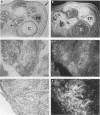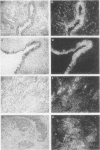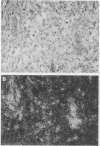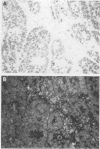Abstract
AIMS/BACKGROUND: The H19 gene is an imprinted, maternally expressed gene in humans. It is tightly linked and coregulated with the imprinted, paternally expressed gene of insulin-like growth factor 2. The H19 gene product is not translated into protein and functions as an RNA molecule. Although its role has been investigated for more than a decade, its biological function is still not understood fully. H19 is abundantly expressed in many tissues from early stages of embryogenesis through fetal life, and is down regulated postnatally. It is also expressed in certain childhood and adult tumours. This study was designed to screen the expression of H19 in human cancer and its relation to the expression of H19 in the fetus. METHODS: Using in situ hybridisation with a [35S] labelled probe, H19 mRNA was detected in paraffin wax sections of fetal tissues from the first and second trimesters of pregnancy and of a large array of human adult and childhood tumours arising from these tissues. RESULTS: The H19 gene is expressed in tumours arising from tissues which express this gene in fetal life. Its expression in the fetus and in cancer is closely linked with tissue differentiation. CONCLUSIONS: Based on these and previous data, H19 is neither a tumour suppressor gene nor an oncogene. Its product is an oncofetal RNA. The potential use of this RNA as a tumour marker should be evaluated.
Full text
PDF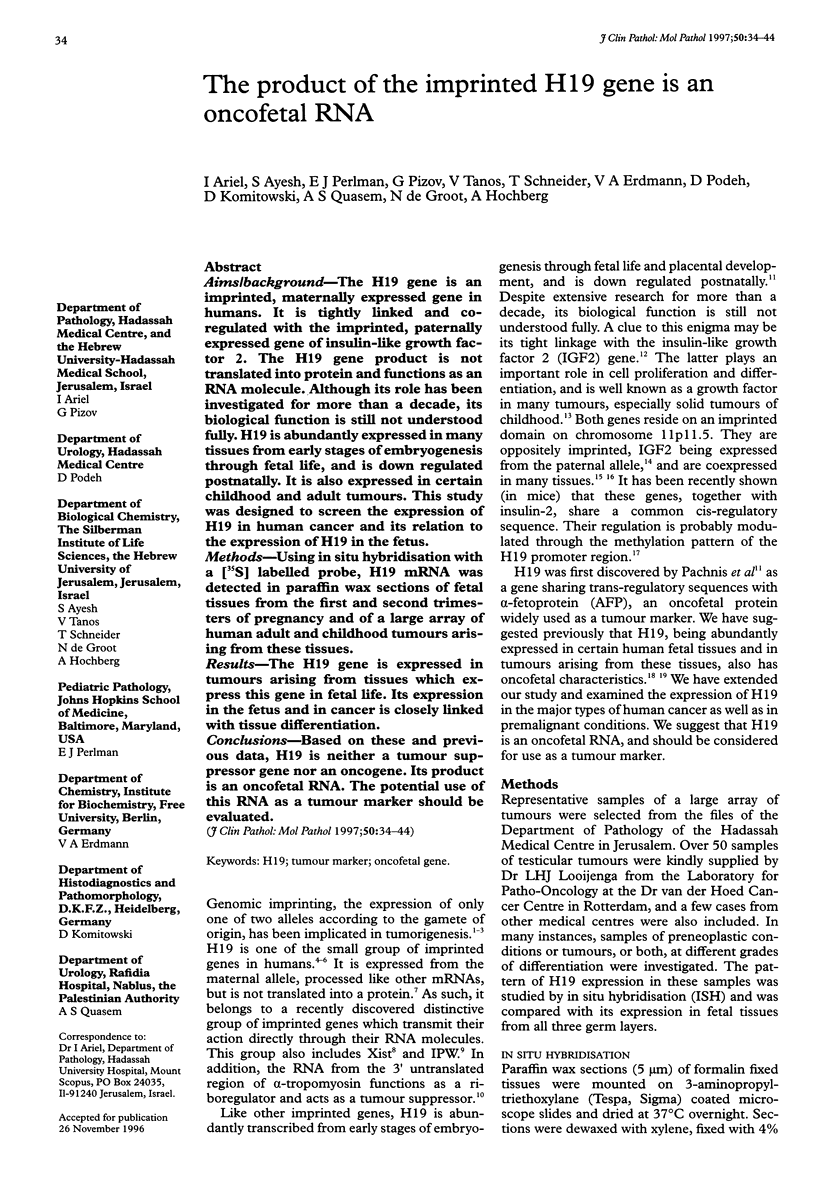
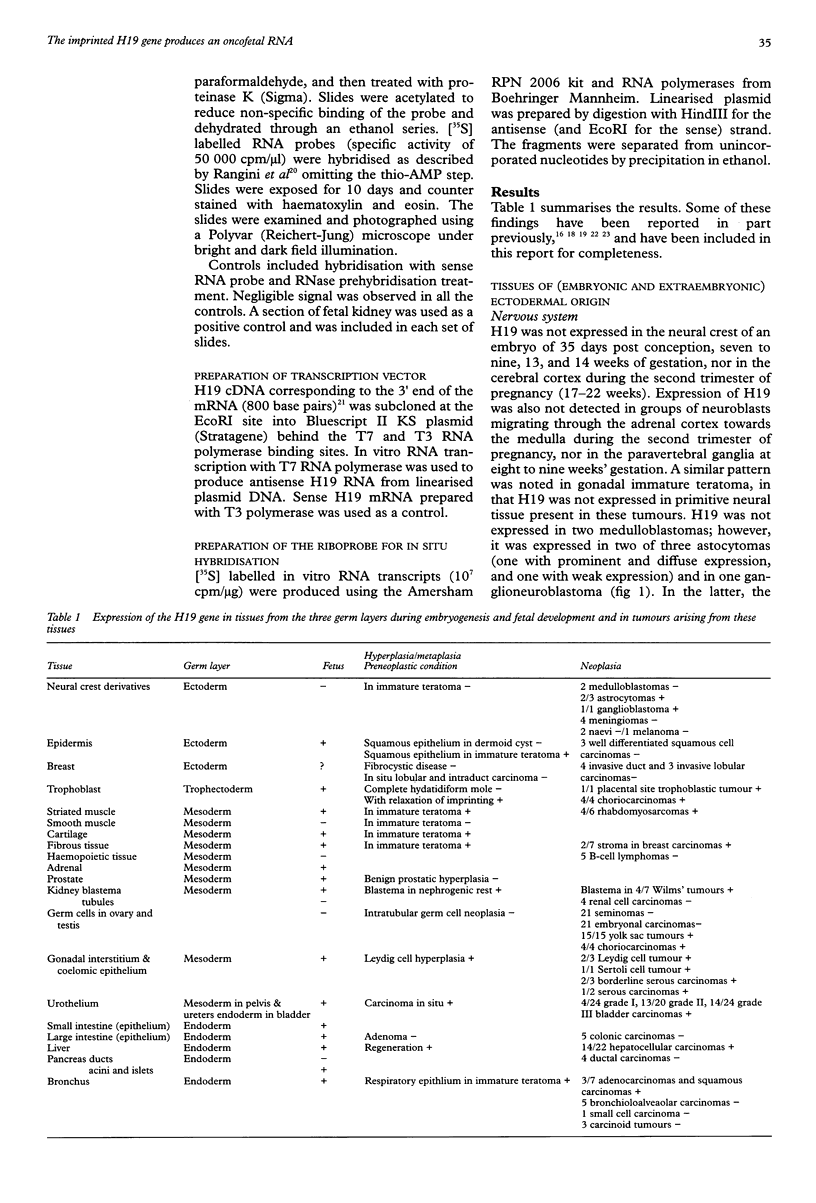
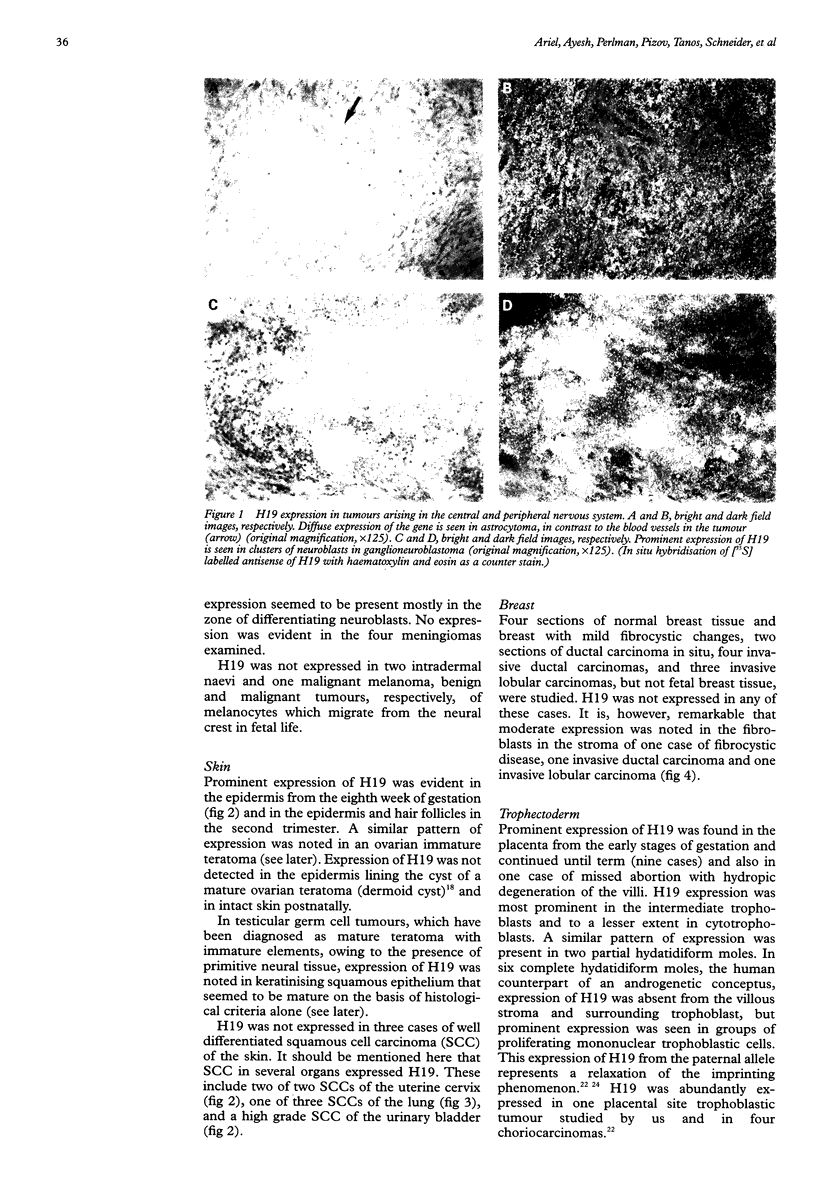
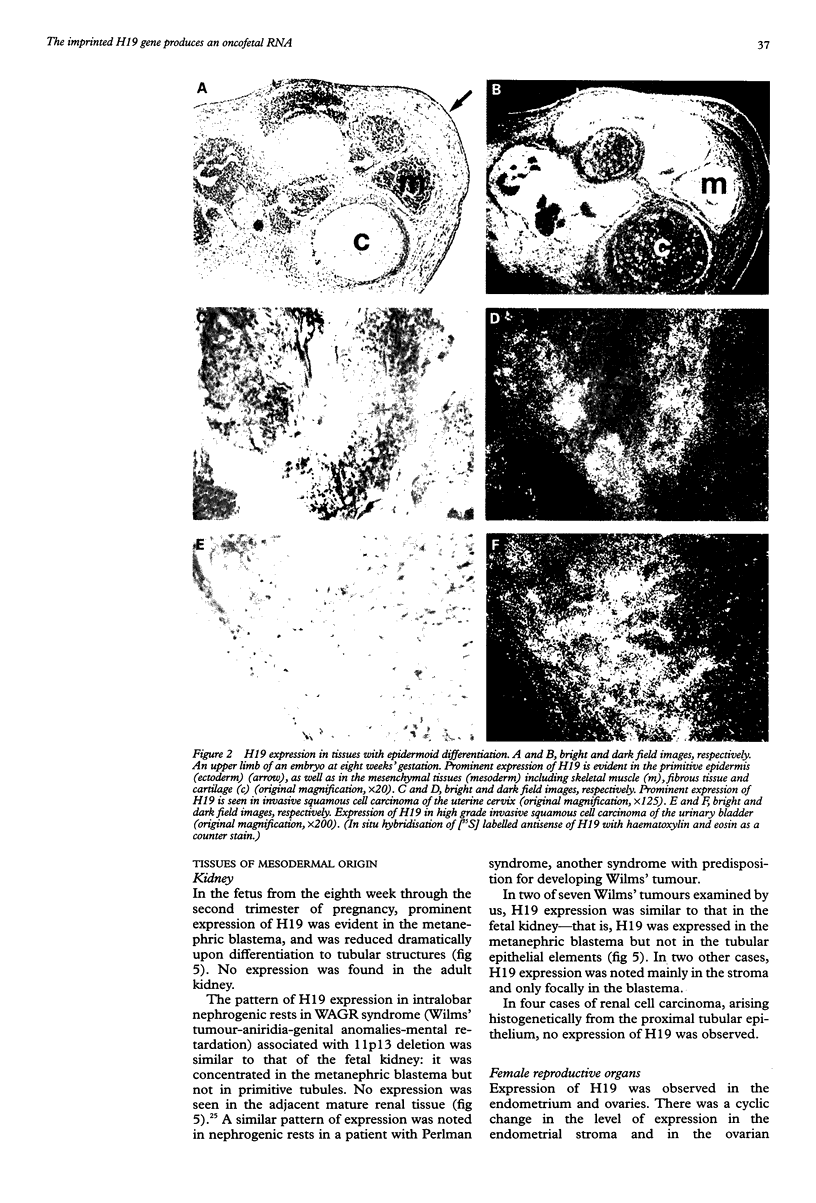
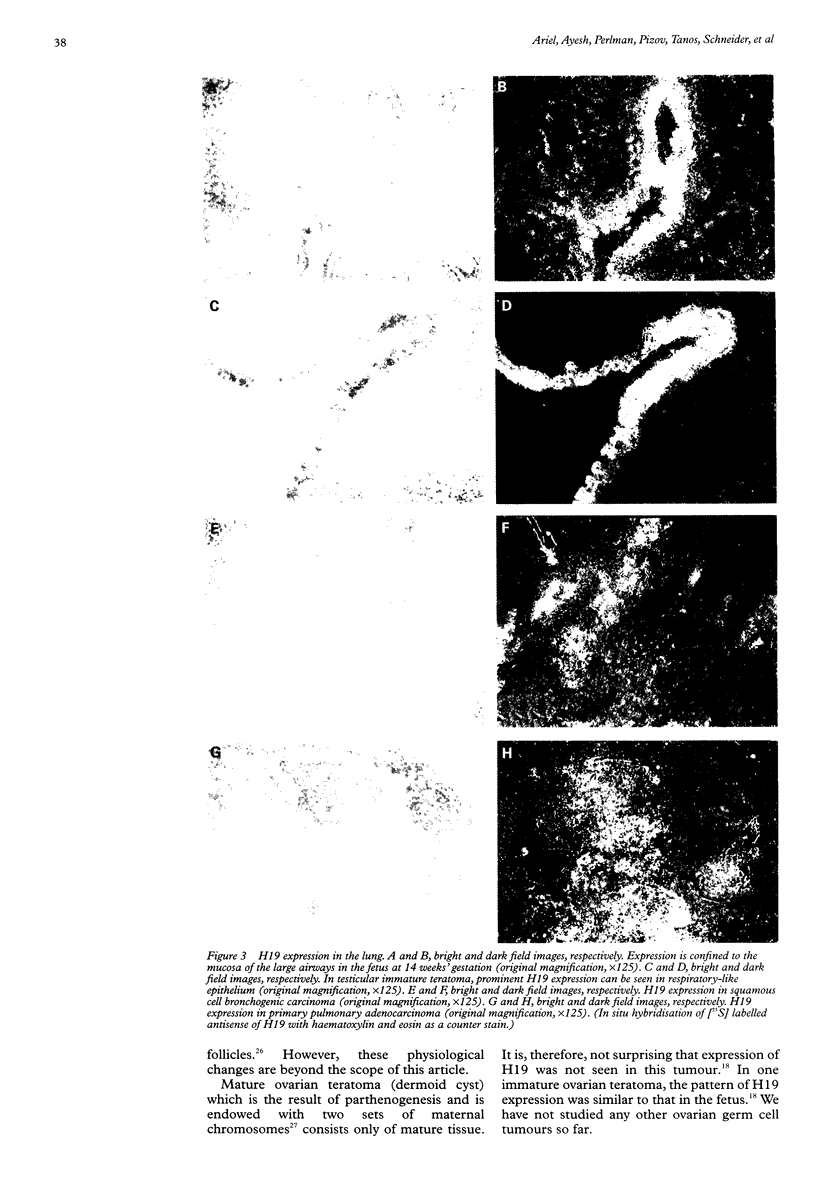
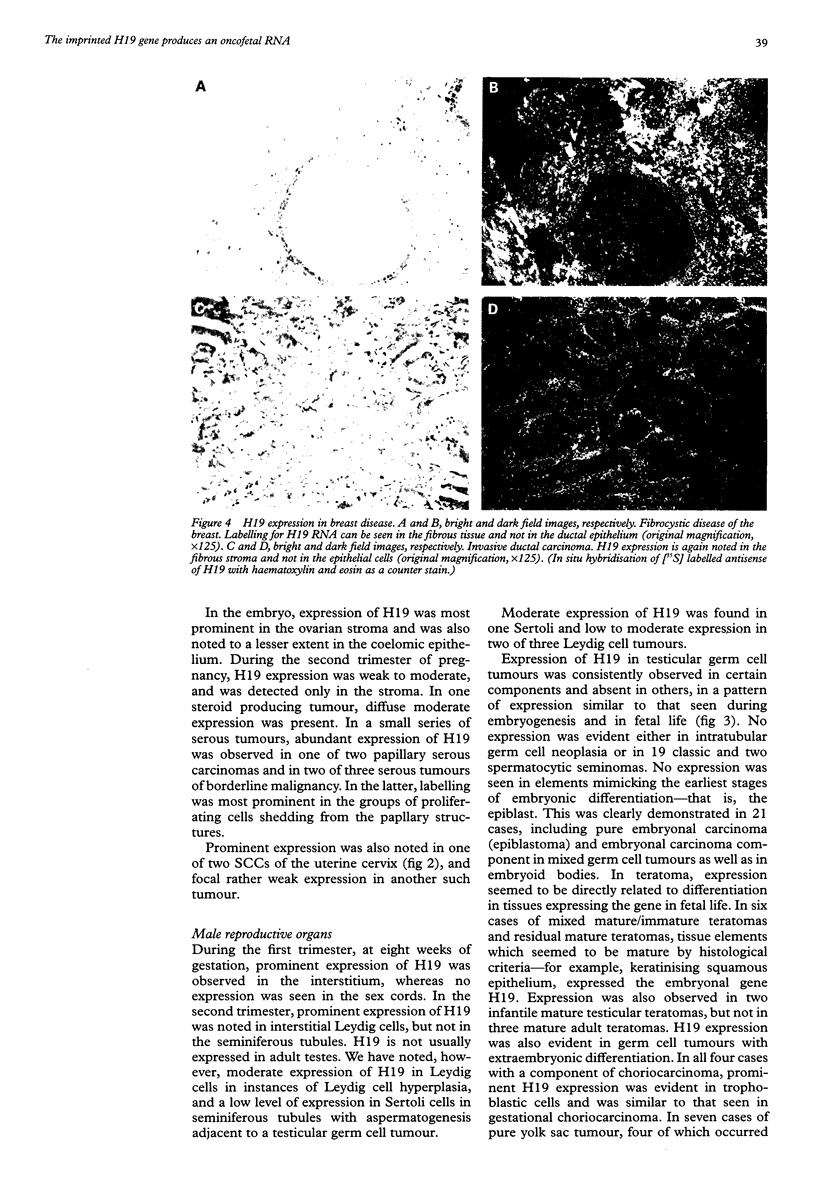
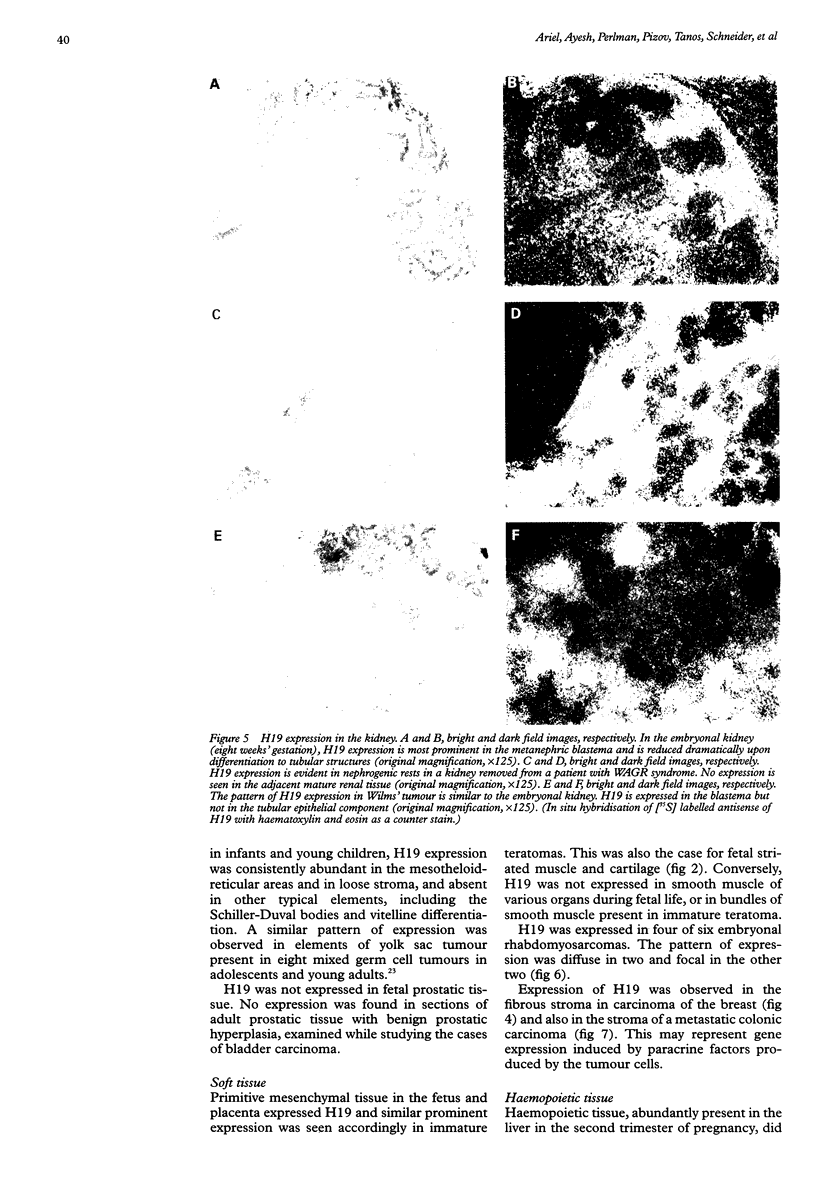
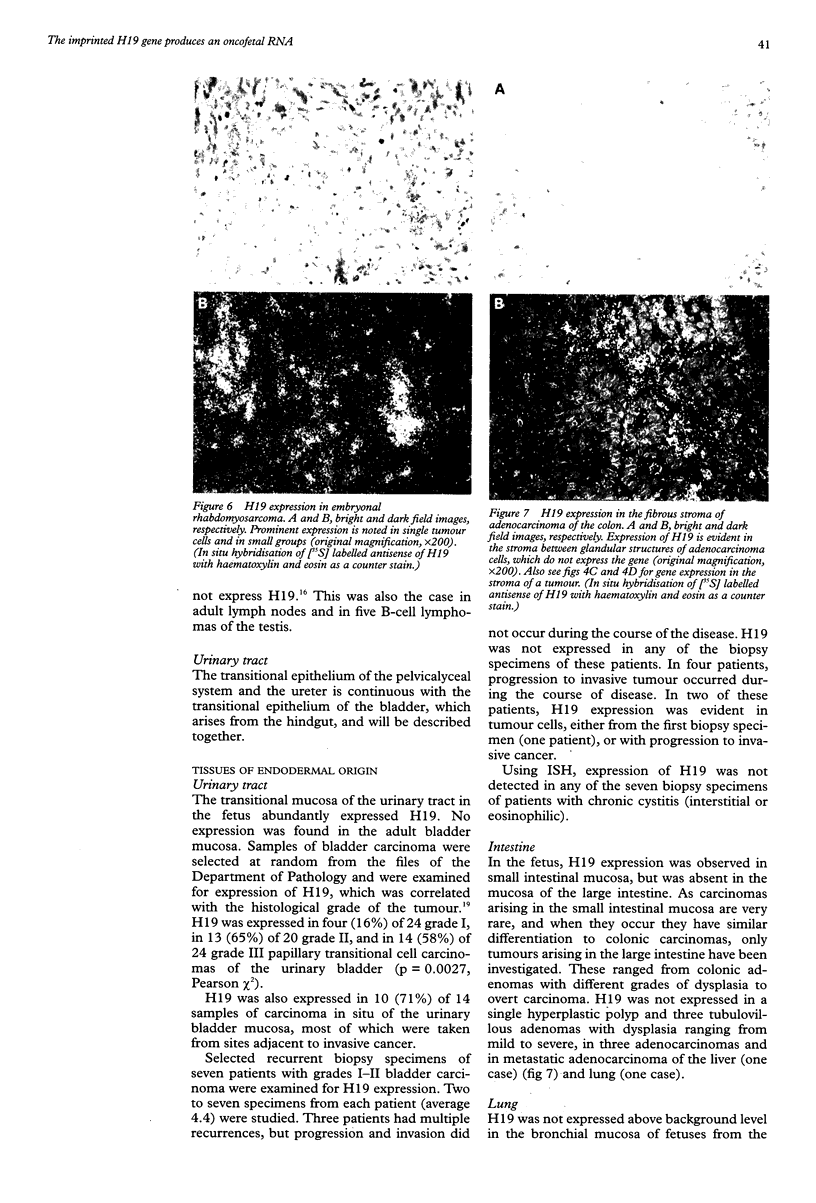
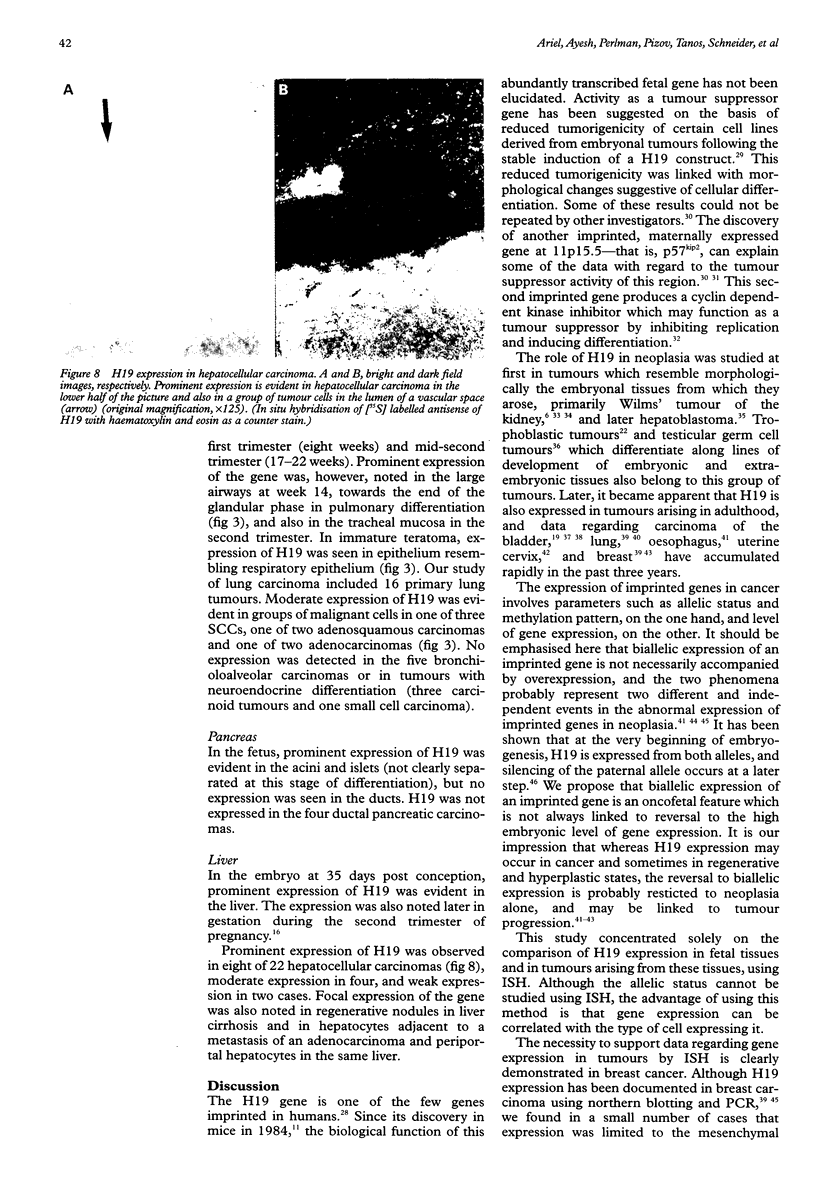

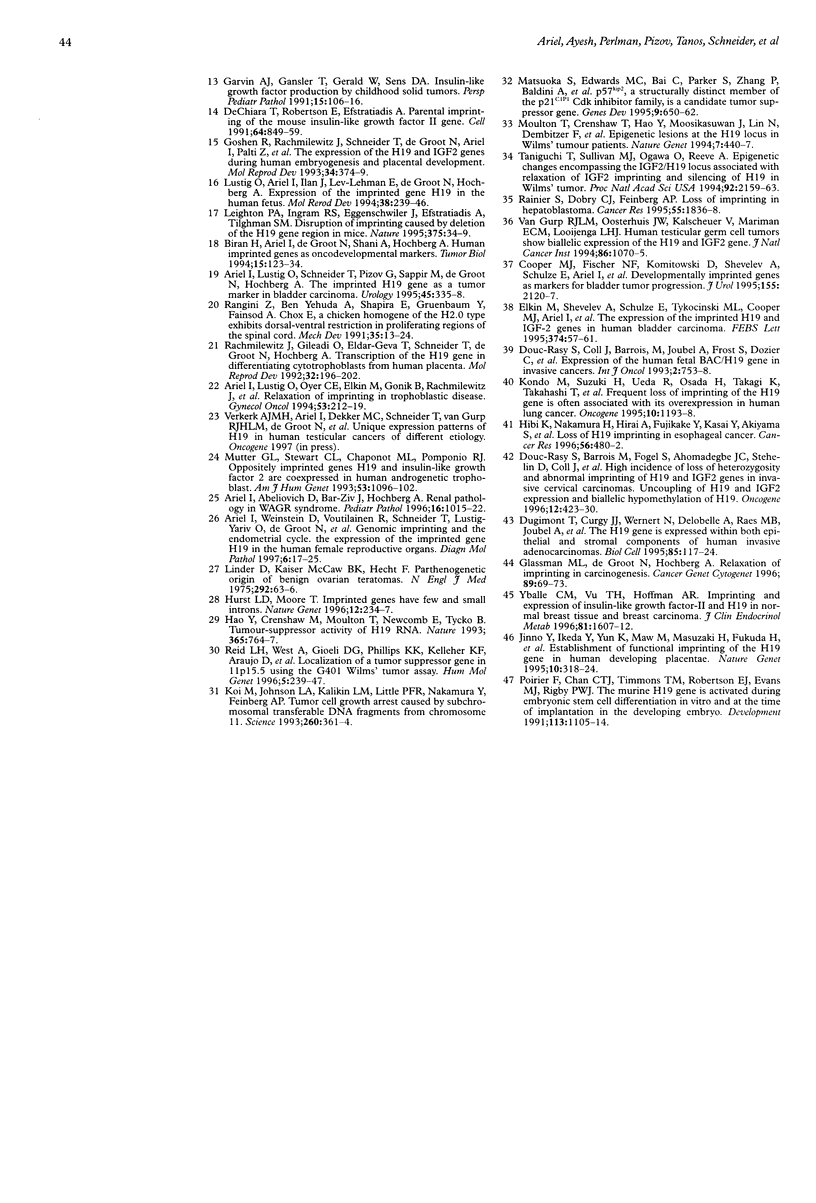
Images in this article
Selected References
These references are in PubMed. This may not be the complete list of references from this article.
- Ariel I., Lustig O., Oyer C. E., Elkin M., Gonik B., Rachmilewitz J., Biran H., Goshen R., de Groot N., Hochberg A. Relaxation of imprinting in trophoblastic disease. Gynecol Oncol. 1994 May;53(2):212–219. doi: 10.1006/gyno.1994.1118. [DOI] [PubMed] [Google Scholar]
- Ariel I., Lustig O., Schneider T., Pizov G., Sappir M., De-Groot N., Hochberg A. The imprinted H19 gene as a tumor marker in bladder carcinoma. Urology. 1995 Feb;45(2):335–338. doi: 10.1016/0090-4295(95)80030-1. [DOI] [PubMed] [Google Scholar]
- Ariel I., Weinstein D., Voutilainen R., Schneider T., Lustig-Yariv O., de Groot N., Hochberg A. Genomic imprinting and the endometrial cycle. The expression of the imprinted gene H19 in the human female reproductive organs. Diagn Mol Pathol. 1997 Feb;6(1):17–25. doi: 10.1097/00019606-199702000-00004. [DOI] [PubMed] [Google Scholar]
- Biran H., Ariel I., de Groot N., Shani A., Hochberg A. Human imprinted genes as oncodevelopmental markers. Tumour Biol. 1994;15(3):123–134. doi: 10.1159/000217882. [DOI] [PubMed] [Google Scholar]
- Brannan C. I., Dees E. C., Ingram R. S., Tilghman S. M. The product of the H19 gene may function as an RNA. Mol Cell Biol. 1990 Jan;10(1):28–36. doi: 10.1128/mcb.10.1.28. [DOI] [PMC free article] [PubMed] [Google Scholar]
- Brockdorff N., Ashworth A., Kay G. F., McCabe V. M., Norris D. P., Cooper P. J., Swift S., Rastan S. The product of the mouse Xist gene is a 15 kb inactive X-specific transcript containing no conserved ORF and located in the nucleus. Cell. 1992 Oct 30;71(3):515–526. doi: 10.1016/0092-8674(92)90519-i. [DOI] [PubMed] [Google Scholar]
- Cooper M. J., Fischer M., Komitowski D., Shevelev A., Schulze E., Ariel I., Tykocinski M. L., Miron S., Ilan J., de Groot N. Developmentally imprinted genes as markers for bladder tumor progression. J Urol. 1996 Jun;155(6):2120–2127. [PubMed] [Google Scholar]
- DeChiara T. M., Robertson E. J., Efstratiadis A. Parental imprinting of the mouse insulin-like growth factor II gene. Cell. 1991 Feb 22;64(4):849–859. doi: 10.1016/0092-8674(91)90513-x. [DOI] [PubMed] [Google Scholar]
- Douc-Rasy S., Barrois M., Fogel S., Ahomadegbe J. C., Stéhelin D., Coll J., Riou G. High incidence of loss of heterozygosity and abnormal imprinting of H19 and IGF2 genes in invasive cervical carcinomas. Uncoupling of H19 and IGF2 expression and biallelic hypomethylation of H19. Oncogene. 1996 Jan 18;12(2):423–430. [PubMed] [Google Scholar]
- Dugimont T., Curgy J. J., Wernert N., Delobelle A., Raes M. B., Joubel A., Stehelin D., Coll J. The H19 gene is expressed within both epithelial and stromal components of human invasive adenocarcinomas. Biol Cell. 1995;85(2-3):117–124. doi: 10.1016/0248-4900(96)85272-5. [DOI] [PubMed] [Google Scholar]
- Elkin M., Shevelev A., Schulze E., Tykocinsky M., Cooper M., Ariel I., Pode D., Kopf E., de Groot N., Hochberg A. The expression of the imprinted H19 and IGF-2 genes in human bladder carcinoma. FEBS Lett. 1995 Oct 23;374(1):57–61. doi: 10.1016/0014-5793(95)01074-o. [DOI] [PubMed] [Google Scholar]
- Feinberg A. P. Genomic imprinting and gene activation in cancer. Nat Genet. 1993 Jun;4(2):110–113. doi: 10.1038/ng0693-110. [DOI] [PubMed] [Google Scholar]
- Garvin A. J., Gansler T., Gerald W., Sens D. A. Insulin-like growth factor production by childhood solid tumors. Perspect Pediatr Pathol. 1991;15:106–116. [PubMed] [Google Scholar]
- Glassman M. L., de Groot N., Hochberg A. Relaxation of imprinting in carcinogenesis. Cancer Genet Cytogenet. 1996 Jul 1;89(1):69–73. doi: 10.1016/0165-4608(95)00364-9. [DOI] [PubMed] [Google Scholar]
- Goshen R., Rachmilewitz J., Schneider T., de-Groot N., Ariel I., Palti Z., Hochberg A. A. The expression of the H-19 and IGF-2 genes during human embryogenesis and placental development. Mol Reprod Dev. 1993 Apr;34(4):374–379. doi: 10.1002/mrd.1080340405. [DOI] [PubMed] [Google Scholar]
- Hao Y., Crenshaw T., Moulton T., Newcomb E., Tycko B. Tumour-suppressor activity of H19 RNA. Nature. 1993 Oct 21;365(6448):764–767. doi: 10.1038/365764a0. [DOI] [PubMed] [Google Scholar]
- Hibi K., Nakamura H., Hirai A., Fujikake Y., Kasai Y., Akiyama S., Ito K., Takagi H. Loss of H19 imprinting in esophageal cancer. Cancer Res. 1996 Feb 1;56(3):480–482. [PubMed] [Google Scholar]
- Hochberg A., Gonik B., Goshen R., de Groot N. A growing relationship between genomic imprinting and tumorigenesis. Cancer Genet Cytogenet. 1994 Mar;73(1):82–83. doi: 10.1016/0165-4608(94)90188-0. [DOI] [PubMed] [Google Scholar]
- Hurst L. D., McVean G., Moore T. Imprinted genes have few and small introns. Nat Genet. 1996 Mar;12(3):234–237. doi: 10.1038/ng0396-234. [DOI] [PubMed] [Google Scholar]
- Jinno Y., Ikeda Y., Yun K., Maw M., Masuzaki H., Fukuda H., Inuzuka K., Fujishita A., Ohtani Y., Okimoto T. Establishment of functional imprinting of the H19 gene in human developing placentae. Nat Genet. 1995 Jul;10(3):318–324. doi: 10.1038/ng0795-318. [DOI] [PubMed] [Google Scholar]
- Koi M., Johnson L. A., Kalikin L. M., Little P. F., Nakamura Y., Feinberg A. P. Tumor cell growth arrest caused by subchromosomal transferable DNA fragments from chromosome 11. Science. 1993 Apr 16;260(5106):361–364. doi: 10.1126/science.8469989. [DOI] [PubMed] [Google Scholar]
- Kondo M., Suzuki H., Ueda R., Osada H., Takagi K., Takahashi T., Takahashi T. Frequent loss of imprinting of the H19 gene is often associated with its overexpression in human lung cancers. Oncogene. 1995 Mar 16;10(6):1193–1198. [PubMed] [Google Scholar]
- Leighton P. A., Ingram R. S., Eggenschwiler J., Efstratiadis A., Tilghman S. M. Disruption of imprinting caused by deletion of the H19 gene region in mice. Nature. 1995 May 4;375(6526):34–39. doi: 10.1038/375034a0. [DOI] [PubMed] [Google Scholar]
- Lustig O., Ariel I., Ilan J., Lev-Lehman E., De-Groot N., Hochberg A. Expression of the imprinted gene H19 in the human fetus. Mol Reprod Dev. 1994 Jul;38(3):239–246. doi: 10.1002/mrd.1080380302. [DOI] [PubMed] [Google Scholar]
- Matsuoka S., Edwards M. C., Bai C., Parker S., Zhang P., Baldini A., Harper J. W., Elledge S. J. p57KIP2, a structurally distinct member of the p21CIP1 Cdk inhibitor family, is a candidate tumor suppressor gene. Genes Dev. 1995 Mar 15;9(6):650–662. doi: 10.1101/gad.9.6.650. [DOI] [PubMed] [Google Scholar]
- Moulton T., Crenshaw T., Hao Y., Moosikasuwan J., Lin N., Dembitzer F., Hensle T., Weiss L., McMorrow L., Loew T. Epigenetic lesions at the H19 locus in Wilms' tumour patients. Nat Genet. 1994 Jul;7(3):440–447. doi: 10.1038/ng0794-440. [DOI] [PubMed] [Google Scholar]
- Mutter G. L., Stewart C. L., Chaponot M. L., Pomponio R. J. Oppositely imprinted genes H19 and insulin-like growth factor 2 are coexpressed in human androgenetic trophoblast. Am J Hum Genet. 1993 Nov;53(5):1096–1102. [PMC free article] [PubMed] [Google Scholar]
- Pachnis V., Belayew A., Tilghman S. M. Locus unlinked to alpha-fetoprotein under the control of the murine raf and Rif genes. Proc Natl Acad Sci U S A. 1984 Sep;81(17):5523–5527. doi: 10.1073/pnas.81.17.5523. [DOI] [PMC free article] [PubMed] [Google Scholar]
- Poirier F., Chan C. T., Timmons P. M., Robertson E. J., Evans M. J., Rigby P. W. The murine H19 gene is activated during embryonic stem cell differentiation in vitro and at the time of implantation in the developing embryo. Development. 1991 Dec;113(4):1105–1114. doi: 10.1242/dev.113.4.1105. [DOI] [PubMed] [Google Scholar]
- Rachmilewitz J., Gileadi O., Eldar-Geva T., Schneider T., de-Groot N., Hochberg A. Transcription of the H19 gene in differentiating cytotrophoblasts from human placenta. Mol Reprod Dev. 1992 Jul;32(3):196–202. doi: 10.1002/mrd.1080320303. [DOI] [PubMed] [Google Scholar]
- Rachmilewitz J., Goshen R., Ariel I., Schneider T., de Groot N., Hochberg A. Parental imprinting of the human H19 gene. FEBS Lett. 1992 Aug 31;309(1):25–28. doi: 10.1016/0014-5793(92)80731-u. [DOI] [PubMed] [Google Scholar]
- Rainier S., Dobry C. J., Feinberg A. P. Loss of imprinting in hepatoblastoma. Cancer Res. 1995 May 1;55(9):1836–1838. [PubMed] [Google Scholar]
- Rainier S., Johnson L. A., Dobry C. J., Ping A. J., Grundy P. E., Feinberg A. P. Relaxation of imprinted genes in human cancer. Nature. 1993 Apr 22;362(6422):747–749. doi: 10.1038/362747a0. [DOI] [PubMed] [Google Scholar]
- Rangini Z., Ben-Yehuda A., Shapira E., Gruenbaum Y., Fainsod A. CHox E, a chicken homeogene of the H2.0 type exhibits dorso-ventral restriction in the proliferating region of the spinal cord. Mech Dev. 1991 Aug;35(1):13–24. doi: 10.1016/0925-4773(91)90037-7. [DOI] [PubMed] [Google Scholar]
- Rastinejad F., Conboy M. J., Rando T. A., Blau H. M. Tumor suppression by RNA from the 3' untranslated region of alpha-tropomyosin. Cell. 1993 Dec 17;75(6):1107–1117. doi: 10.1016/0092-8674(93)90320-p. [DOI] [PubMed] [Google Scholar]
- Reid L. H., West A., Gioeli D. G., Phillips K. K., Kelleher K. F., Araujo D., Stanbridge E. J., Dowdy S. F., Gerhard D. S., Weissman B. E. Localization of a tumor suppressor gene in 11p15.5 using the G401 Wilms' tumor assay. Hum Mol Genet. 1996 Feb;5(2):239–247. doi: 10.1093/hmg/5.2.239. [DOI] [PubMed] [Google Scholar]
- Taniguchi T., Sullivan M. J., Ogawa O., Reeve A. E. Epigenetic changes encompassing the IGF2/H19 locus associated with relaxation of IGF2 imprinting and silencing of H19 in Wilms tumor. Proc Natl Acad Sci U S A. 1995 Mar 14;92(6):2159–2163. doi: 10.1073/pnas.92.6.2159. [DOI] [PMC free article] [PubMed] [Google Scholar]
- Tycko B. Genomic imprinting: mechanism and role in human pathology. Am J Pathol. 1994 Mar;144(3):431–443. [PMC free article] [PubMed] [Google Scholar]
- Wevrick R., Kerns J. A., Francke U. Identification of a novel paternally expressed gene in the Prader-Willi syndrome region. Hum Mol Genet. 1994 Oct;3(10):1877–1882. doi: 10.1093/hmg/3.10.1877. [DOI] [PubMed] [Google Scholar]
- Yballe C. M., Vu T. H., Hoffman A. R. Imprinting and expression of insulin-like growth factor-II and H19 in normal breast tissue and breast tumor. J Clin Endocrinol Metab. 1996 Apr;81(4):1607–1612. doi: 10.1210/jcem.81.4.8636375. [DOI] [PubMed] [Google Scholar]
- Zemel S., Bartolomei M. S., Tilghman S. M. Physical linkage of two mammalian imprinted genes, H19 and insulin-like growth factor 2. Nat Genet. 1992 Sep;2(1):61–65. doi: 10.1038/ng0992-61. [DOI] [PubMed] [Google Scholar]
- Zhang Y., Tycko B. Monoallelic expression of the human H19 gene. Nat Genet. 1992 Apr;1(1):40–44. doi: 10.1038/ng0492-40. [DOI] [PubMed] [Google Scholar]
- van Gurp R. J., Oosterhuis J. W., Kalscheuer V., Mariman E. C., Looijenga L. H. Biallelic expression of the H19 and IGF2 genes in human testicular germ cell tumors. J Natl Cancer Inst. 1994 Jul 20;86(14):1070–1075. doi: 10.1093/jnci/86.14.1070. [DOI] [PubMed] [Google Scholar]




